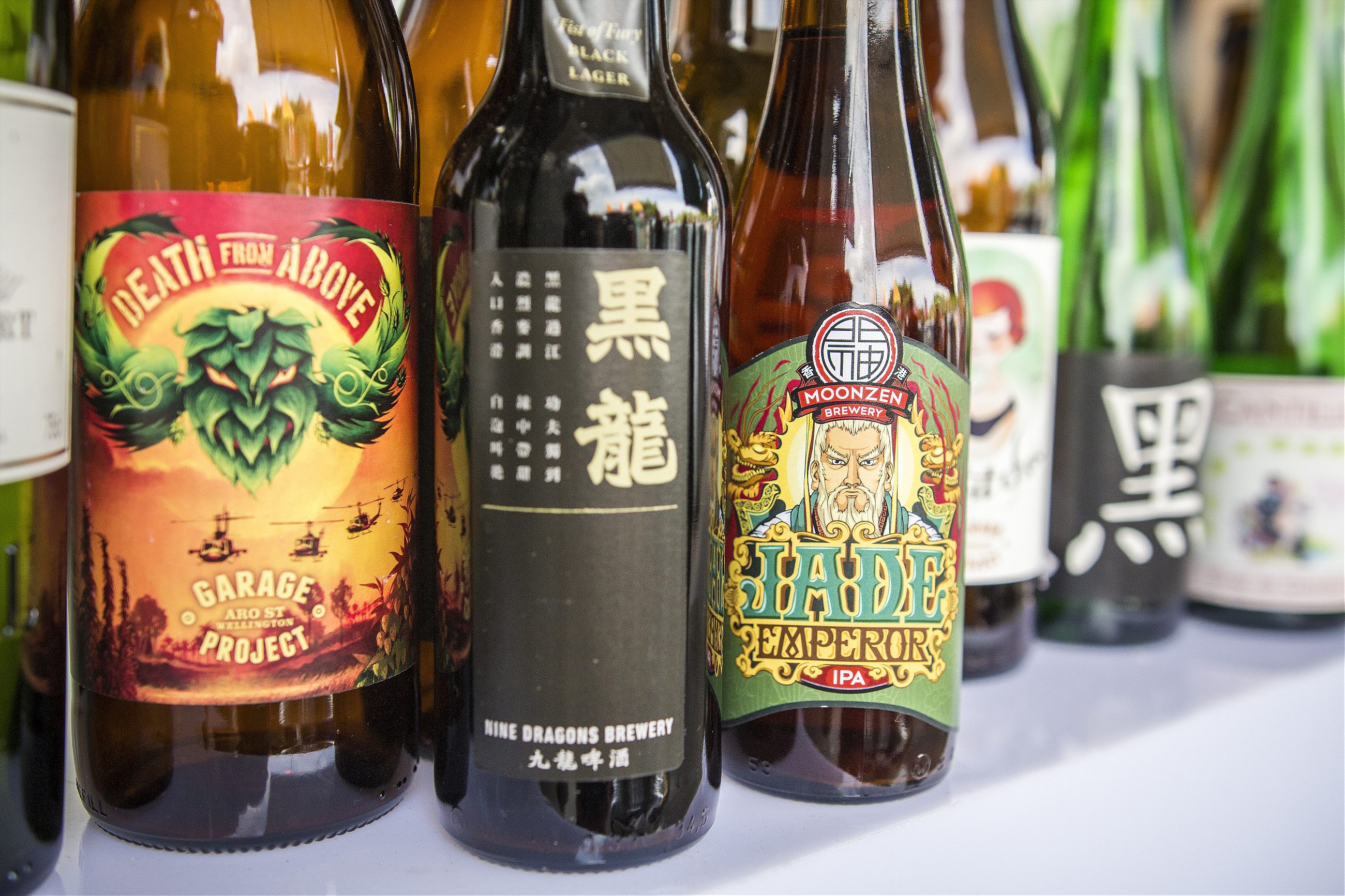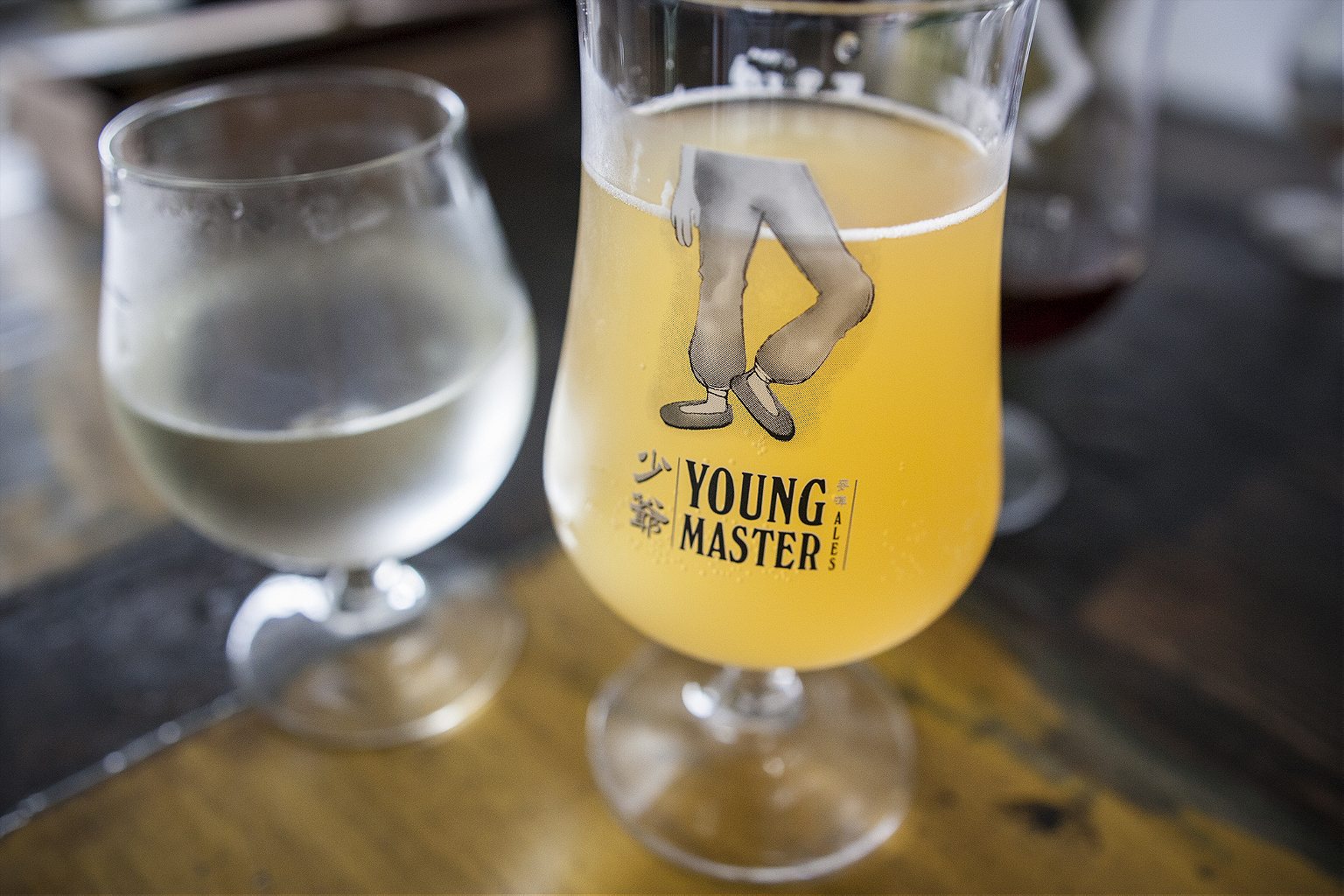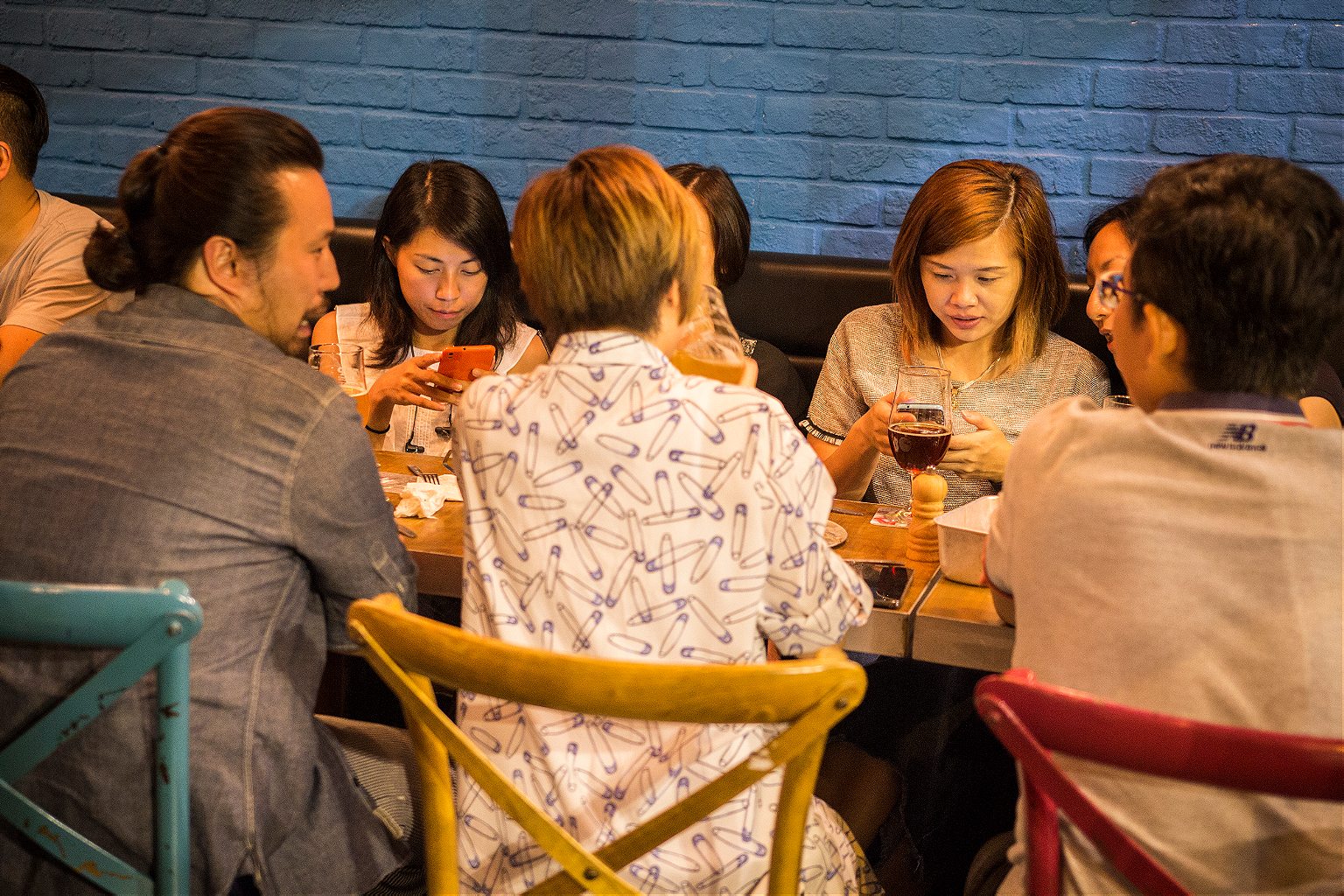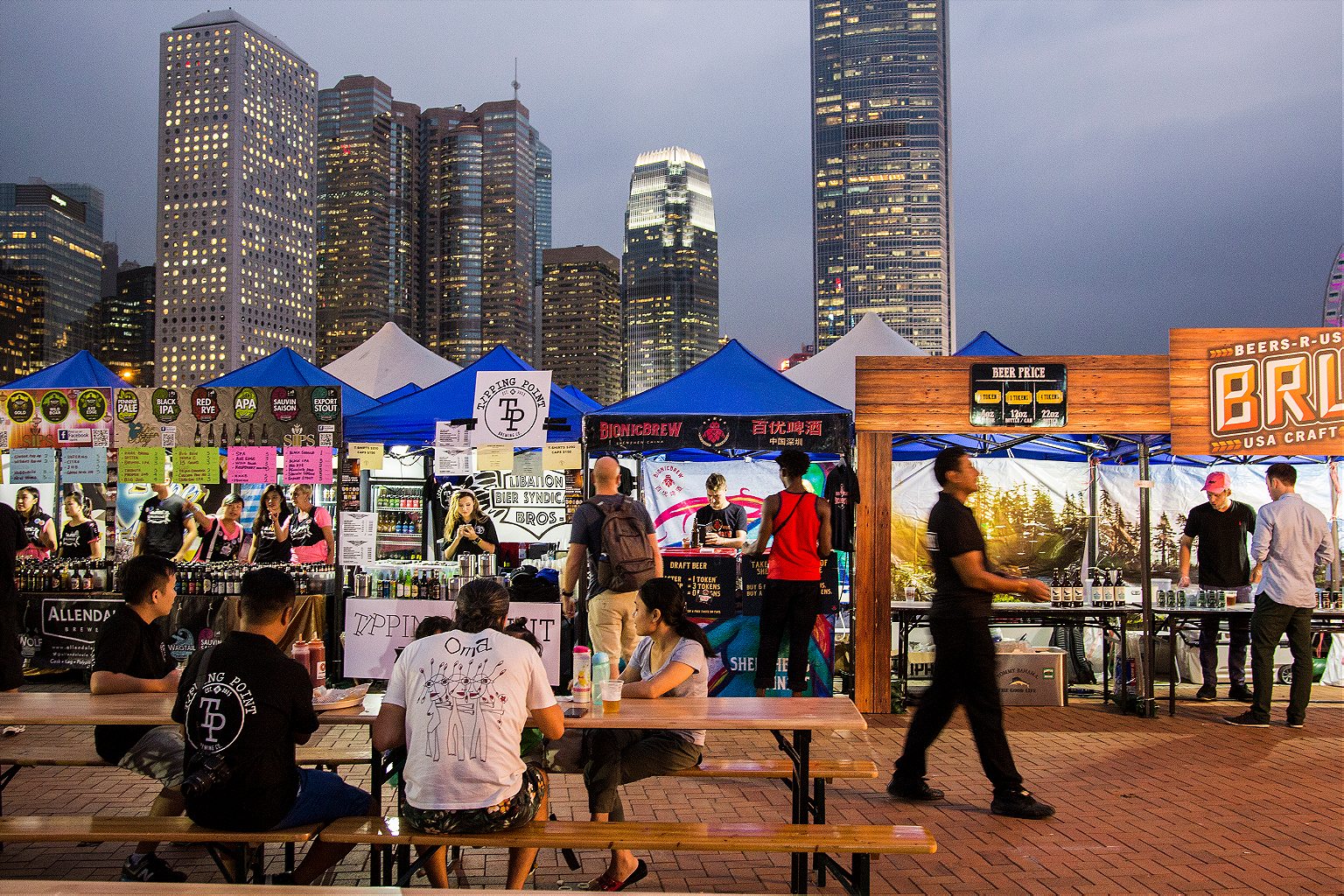Brewers in Hong Kong and Beijing are creating distinctively Chinese beers unlike anything else in the world
It’s a balmy Thursday evening in Hong Kong and a crowd with pints of beer in their hands is spilling out onto the steep slope of Peel Street in the Soho neighborhood. It’s well past happy hour, so they’re here for a reason: the launch of One Beer, Two Systems, a collaboration between two of the most exciting breweries in Asia, Jing A Brewing from Beijing and Moonzen Brewery from Hong Kong.
I push my way through the crowd with my wife, Laine, who orders a bottle of the new beer. She pours it into a glass and takes a sip. “It tastes like suen mui tong!” she exclaims—smoky and sweet, with just a hint of tartness, exactly like the sour plum drink you get when you’re eating hot pot.
“Good, because that’s exactly what it is,” says Moonzen’s brewer, Laszlo Raphael, who is standing nearby. Jing A’s Kristian Li grins and raises his glass in appreciation.
This is the first time breweries from Beijing and Hong Kong have worked together, though it hasn’t exactly been a long time coming. The craft beer revolution reached these shores only a few years ago, bringing with it the same thirst for full-flavored beer that has transformed the market in the United States, where craft now accounts for 11 percent of all beer consumed.
Beijing and Hong Kong each have about a dozen craft breweries, including Moonzen and Jing A. Most of them make beers that would be familiar to any stout lover or IPA drinker in Chicago or New York, but a handful of brewers are going one step further and producing beers that reflect who they are and where they are from: Distinctively Chinese brews that aren’t like anything else around.

One Beer, Two Systems is one of those beers. Its name is a cheeky reference to “one country, two systems,” the compromise hatched by Britain and China that allows Hong Kong to maintain its own laws, language, currency, and political system even though it is officially part of China. The flavor is inspired by suen mui tong, also known by its Mandarin name, suan mei tang.
“Suan mei tang is really popular in Beijing and a lot of people in Hong Kong know about it,” says Li. People in Beijing use it to fight the summer heat, while in subtropical Hong Kong, it’s a staple of hot pot eating, when friends gather around a boiling cauldron filled with meat and veggies.
Li first encountered Moonzen when he visited Hong Kong last spring. “Laszlo is the perfect guy for us to do a brew with because we are very similar in our philosophy about beer,” he says. That’s obvious enough in their branding: Jing A’s name and logo are based on Beijing’s license plates, while Moonzen refers to mun sun, or “door gods,” whose icons are traditionally placed by the entrance of homes and shops for good luck. Each Moonzen beer is named after a different deity, from the Kitchen God Honey Porter (made with lychee-inflected local Hong Kong honey) to the Jade Emperor IPA (a West Coast-style hoppy pale ale).
“All the seasonal beers we do, we release according to the lunar calendar,” says Raphael. He has made beers with local kumquats, osmanthus, chrysanthemum, roselle, and jasmine, along with mouth-numbing Sichuan peppercorns. Earlier this year, Moonzen released a set of two high-alcohol “brew tonics” made according to the “yin yang” principle of balance found in traditional Chinese medicine. One was a wheatwine packed with substances like orange peels, Chinese yam, and lily bulbs, the other an imperial porter made with dong quai, a root with a beguiling bittersweet taste, along with star anise, peony root, and other ingredients.
Raphael was born in Mexico. His father was a brewer by trade and while Raphael pursued engineering, his heritage caught up with him and he eventually became an avid homebrewer. Raphael met his Hong Kong-born wife, Michele Wong, when they were both living in Beijing, and when they moved to Hong Kong a few years ago, they decided to start a brewery. Moonzen occupies a tiny space on the seventh floor of an industrial building in Kwun Tong, a district that made plastic flowers and cheap clothes until all the factories left for Mainland China. Mounted on the wall is an altar to Choi Sun, the Chinese god of wealth, with a bottle of beer presented as an offering.

Across town, on the island of Ap Lei Chau—where hulking factory blocks are wedged between verdant hills and a turquoise sea—I meet another pair of brewers on a similar mission. Delhi-born Rohit Dugar was an investment banker until he founded Young Master Ales in 2013. He was joined by Ulrich Altbauer, a veteran German brewer, and together they have made some remarkable beers, including a robust IPA with passionfruit notes and a rye wine aged in whiskey barrels and bottle-conditioned with whiskey yeast. Earlier this year, Dugar and Altbauer decided to make a gose, a salty-sour style of beer native to Leipzig, Germany. They added salted preserved lime and called it Cha Chaan Teng Gose, an homage to haam ling chut (salted lime 7-Up), a classic beverage in the Hong Kong-style cafés known as cha chaan teng, whose menu and atmosphere fall somewhere between an American diner, a British “caff” and a Chinese takeaway joint.
The gose was a surprise success. What was meant to be a one-off experiment turned out to be the hit of the summer, especially at The Ale Project, a taproom owned by Dugar and two other beer professionals, Chris Wong and Philip Chan. “We didn’t expect it to be so popular, but I think for people it’s the association with salted lime, something very refreshing,” says Dugar when I meet him for a drink at TAP. He explains that he initially used lactobacillus bacteria from Yakult, a popular probiotic drink found in every Hong Kong convenience store, to sour the beer, although ultimately decided to use ready-made bacteria from a health food store, which was more manageable. I look over to the next table, where a middle-aged woman watching Cantonese television on her iPad is already on her second pint of gose.

“We want to use local ingredients, but they need to be rooted in something, where the flavors make sense,” says Dugar. Young Master’s Mo’Mo Wit puts a Chinese spin on a traditional Belgian style, with chun pei (aged Mandarin orange peel), zedoary, coriander seeds, chrysanthemum, chamomile, and white pepper. In the Mood for Spring, a saison, includes jasmine, osmanthus, and chrysanthemum, while the Horny Wongs—a beer originally brewed to celebrate Chris Wong’s wedding—featured locally-grown roselle, a tart, earthy kind of hibiscus flower.
“What we haven’t done so far is take a local ingredient and design an entirely new beer around it,” Dugar says. (That’s not entirely true: one of Young Master’s recent releases is Tai Sui, a barrel-aged wild rye beer fermented with a local baker’s decade-old sourdough starter.) There may yet be room for that kind of experimentation. As the success of the Cha Chaan Teng Gose suggests, Hong Kong drinkers are more adventurous than many brewers expected.
“Expats tend to think that craft beer equals IPA, but for locals, it’s all new. They don’t have any preconceptions,” says James Ling, TAP’s general manager. Kristian Li says that when Jing A sent its beers to Hong Kong for the first time in October, their best-seller was the Koji Red Ale, an unusual brew made with sake rice, wasabi, ginger and lemony Sorachi Ace hops. “For some reason it really struck a chord with people there,” he says.

Not long after the launch of One Beer, Two Systems, I find myself sitting on the patio of Jing A’s new Beijing bar with Kristian Li and Richard Ammerman, who handles the brewery’s marketing. Though it was launched less than two years ago, Jing A is already one of Beijing’s most popular craft breweries, with a line of beers that balance staples like IPAs and stouts with distinctly Beijing concoctions like the Big Slice Watermelon Wheat.
“Watermelons are such a popular snack in the summer,” Ammerman says. “You see people hauling them around in the hutongs,” the ancient alleyways that form the heart and soul of Beijing. The watermelon comes from a farmer just outside the city who has developed his own strain of melon. “He’s rough and tumble, the kind of guy who eats watermelon, drinks and smokes at the same time.” Another farmer provides Jing A with chestnuts for its autumn seasonal brown ale. “We’re interested in seeing where these things are actually growth,” says Ammerman. “Also, it’s cheaper.”
Last year, Jing A released a beer made with sweet potatoes and cumin, a nod to a staple of local street food. The brewery also made the first commercially released beer fermented with baijiu yeast, which is normally used to make China’s ubiquitous firewater. “We’re probably not going to make a beer that has chili oil or stinky tofu,” Ammerman says. “There’s some Beijing ingredients that just don’t sit well in a beer.”
He pauses and thinks for a moment. “Actually, I have always wanted to make a yangrou chuan’r beer,” he says, referring to the spiced lamb skewers that Muslim street vendors serve all over the city. Li looks excited, then contemplative, as if he is preparing a recipe in his head. “You’d need a little bit of the smoke and savory, some cumin in there, maybe a little bit of heat.”

Jing A’s bar is located in the expat-heavy bar district of Sanlitun, where it is joined by a handful of other brewery taprooms, along with countless bars whose fridges are stocked full of imports like Rogue and Brewdog. But the birthplace of craft beer in Beijing is a few miles away, in a small grey brick house in a hutong whose history stretches back several hundred years. That’s where I meet Carl Setzer, who opened Great Leap Brewing in 2010 with his wife, Liu Fang. He is sitting in the courtyard patio next to the trunk of a poplar tree whose leaves are rustling in the wind.
“That’s where it started,” he says, pointing to a shed nearby. Great Leap’s first two beers were the Honey Ma Gold, a blonde ale made with floral Sichuan peppercorns, and the Cinnamon Rock Candy Ale, made with Chinese candied sugar. Since then, the brewery has expanded to two new brewpubs, with a suite of distinctive beers, including many made with tea—a tricky feat, since brewing beer with tea often results in unwanted astringency.
But it isn’t tea that Setzer has on his mind; it’s hops. Great Leap is one of the only craft breweries to rely heavily on Chinese-grown hops, especially the indigenous Qingdao Flower hops, which have a floral aroma and a creamy, almost melon-like flavor. I’m drinking a pint of Hop God Imperial IPA, a showcase for Qingdao Flower. Setzer jabs his finger at my drink. “This is Chinese—Chinese malt, Chinese hops,” he says. “We didn’t start using imported hops until later. I’m still the only brewery in China that believes in Qingdao Flower hops.”
If it seems like Setzer has a chip on his shoulder, it’s because he does. “People call me the Beer Dictator,” he says. For years, he has called out unprofessional practices among Chinese craft brewers, like misrepresenting production output, that could turn off customers and scare away future investors. He tells anyone who will listen that China’s other craft brewers aren’t doing enough to make their beer, well, Chinese. That goes beyond adding tea or chun pei or chestnuts to a brew; it means developing the same kind of high-quality infrastructure that craft brewing has in the United States, from malt production to hop growing to production and distribution.
If it’s just a commodity, they’re going to treat it like shit
Setzer has reason to be discouraged. He tells me that he recently switched from using pelletized Qingdao Flower hops to whole dried hop flowers, which are delivered compressed into a bale. “When you’re breaking apart the pressed flower, you’re finding cigarette butts and stones, pieces of metal and shit,” he says. “You’re like, okay, if I’m finding it in the compressed bale, then it’s definitely going through the hammer mill and getting into the pellets.”
He found out why when he visited China’s isolated hop-growing region in September. “They’re cutting down the hop bines and dragging them across dirty floors. It goes to the long-term attention to quality and love of what the process is. If it’s just a commodity, they’re going to treat it like shit.”
Chinese hops are grown in the country’s far northwest, in poor regions that haven’t seen much investment. Flood-based irrigation limits yields, pickers damage hops and hop bines are stunted growers don’t have the right equipment to harvest the tall bines needed to produce the most flavorful, aromatic hops.
“If you go to Yakima Valley, every farm is totally automated. In China, they hand pick them in the field, or they hand cut them and drag them, losing 20 percent of the flower,” Setzer says. “It’s a very eye-opening realization that if it’s not a development zone outside a first-tier city that they use for marketing, it’s going to be 50 year old technology that nobody cares about, and there’s only one guy in the entire region who knows how to fix it because he’s the one who took the training course when they bought the equipment.”
Setzer says industrial brewers don’t care because they don’t use many hops in their beer, so it’s up to China’s craft brewers to ensure that the country’s hops are up to snuff. Global demand for hops has never been higher, but this year’s hop harvest in Europe and the United States was poor. Chinese craft brewers might soon have no alternative but to use Chinese hops—if they can address the issue of quality. “There’s a massive opportunity here to just give the proverbial finger to anybody that thinks that China needs to cower in the wake of international craft beer,” Setzer says. “We’re sitting on what everybody wants.”
It’s heavy stuff, but Setzer’s mood brightens when the conversation turns to the potential of Chinese beer. “The success we’ve had has inspired a lot of brewers to be more brave,” he says. Earlier this year, he imported some kegs of Young Master Ales to Great Leap. “When I see Rohit do something similar [to us] but incredibly specific to Hong Kong, I swell with pride. It’s amazing.”
Drinkers seem to appreciate the effort too. When I get back to Hong Kong from Beijing, I learn that Young Master has released a new collaboration beer with Shanghai’s Boxing Cat Brewery: the Four Leaves IPA, made with makrut lime leaves. “It’s like how dish soap smells, but in a really good way,” says James Ling when I order a glass at TAP.
I take a sip. It’s an oddball beer, with a hoppy bitterness that gives way to the pronounced zing of lime leaves. As it warms, I can taste the distinctive flavour of Sorachi Ace—lemony and savory, like dill pickles. It’s very good. And I can’t imagine drinking it anywhere else.
CORRECTION: This article originally stated that the Young Master Ales Cha Chaan Teng Gose contained bacteria derived from Yakult. In fact, it was an early version of the beer that used Yakult, but the final version was made with bacteria from another source.